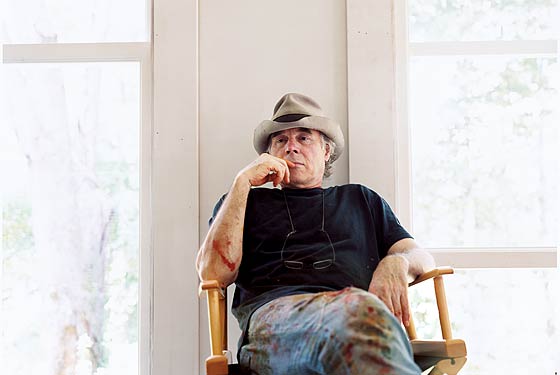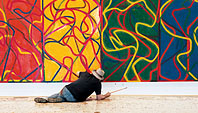
“I totally love the Cézanne bather—the Everyman in isolation, the solitude, which is the way a lot of people are in New York City,” says Brice Marden. He’s talking about one of his favorite masterpieces at MoMA, where—starting October 29—some 50 of his own paintings will hang just a floor above the Cézannes. The last time a local museum gave him a survey (the Guggenheim, in 1975), Marden was 36, making fashionably minimal monochromes titled after downtown musicians like Dylan and Nico in between sessions at Max’s Kansas City. Now he’s a mature painter, with a signature vocabulary of looping, interlaced lines that’s made him, like the bather, a New York icon.
To insiders, a Marden retrospective may seem a conservative choice, one undertaken by a museum looking to shore up its foundation—“classic modern art,” in one critic’s description. His lineage can be traced cleanly through MoMA’s family tree, from late de Kooning right back to Mondrian. Even so, says curator Gary Garrels, Marden has long resisted the idea of a retrospective: “Great artists are always interested in the next thing, not the past. But it was the right time, in terms of where he is with his work.” The MoMA show, which will travel to San Francisco and Berlin, charts Marden’s shift from the early monochrome panels to the meandering, calligraphic marks of his more recent canvases, which can resemble Pollocks encased in layers of ice.

And it is tempting, in view of the gradual extinction of the abstract painter, to see Marden himself as a figure out of the deep-freeze. Yet, as recently as 2002, critics swooned over his two-gallery solo at Matthew Marks. Currently, at his studio in Tivoli, New York, up on the Hudson, Marden is wrestling with two new paintings for the retrospective. The friezelike 24-foot canvases—his biggest yet—adhere to a rigorous color progression, with forms inspired by Chinese scholar’s rocks (Asian art and culture have strongly influenced the layered, curving lines of Marden’s newer compositions). Marden has always been an intensely physical painter, but the dramatic scale of these works required a more demanding approach. “I always used to work paintings leaning against the wall, standing on the ground,” he notes. “The last couple of paintings, when I get to the final stages, I hang them on the wall. That’s how I’m working right now.”
Process is a key to Marden’s endurance in a fickle art world. “It’s interesting how many different artists look at Brice, the way he makes a painting—the facture, the issues of the hand and surface,” says Garrels, who points to Marden’s dialogue with the younger British painter Chris Ofili in the October issue of Artforum. Or, as John Ashbery put it in 1972: “Marden’s surfaces … aren’t, like so much of today’s art, allusions or comments, however oblique, on ideas that are elsewhere: They are themselves what is happening.”
How ironic, then, that abstraction isn’t much in evidence at Rivington Arms, the sceney Lower East Side gallery co-owned by Marden’s daughter Mirabelle. “She doesn’t ask any advice from me, but I really like what she’s doing,” says Marden, who lends his moral support at the gallery’s openings. “I hope she shows more abstract painting. But I just like to be able to see that energy again. You get older, you tend to be more isolated—it’s nice to be snapped out of the isolation.”
—Brice Marden: A Retrospective of Paintings and Drawings, MoMA; October 29 through January 15. Next: Americans in Paris, 1860-1900, Preview